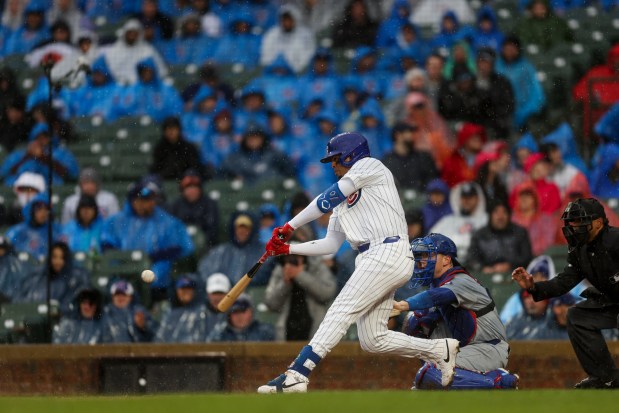The start of the Craig Counsell era at Wrigley Field has been eye-opening.
A 5-1 homestand, fueled by an offense averaging more than six runs per game, has raised expectations on the North Side, which might be premature but is par for the course.
As former Chicago Cubs manager Lou Piniella once said after retiring: “Unless you’re there and you do it … it’s different than what you would think going in. You know, you win three or four games in a row and you’re going to win the pennant. You lose three or four games in a row and the season is over. It isn’t an easy place to manage.”
Counsell’s a quick learner, though, and after nine years of managing in the climate-controlled environment of the ballpark formerly known as Miller Park, he experienced a typical early April week at Wrigley. Cold, wind, rain, sleet, 2-hour, 51-minute delays and only a couple days of sunshine.
“I certainly enjoyed the first week at Wrigley, except for Wednesday night maybe with the weather,” Counsell said. “Other than that it’s been what I thought, and that means it’s not easy. But we’ll tackle the challenges as (we) face them and look forward to getting everyone better.”
The Cubs arrived in San Diego late Sunday for Monday night’s opener of a nine-game West Coast trip that includes stops in Seattle and Arizona. The Cubs bullpen suffered a loss Sunday when durable Julian Merryweather went on the injured list with a right shoulder strain, and by the time they get back home April 18 new challenges will arise.
But the performance of the offense, which entered Monday leading the majors in on-base percentage (.363) and ranking fifth in OPS (.793), has helped alleviate concerns about the bullpen depth or the loss of ace Justin Steele.
The fact Cubs hitters have been so productive in difficult conditions bodes well for when the weather warms up.
“Definitely,” center fielder Cody Bellinger said. “A lot of these guys are used to it, for sure.”
That includes Bellinger, even though he grew up in Arizona and spent the first chapter of his career in Los Angeles, where the term “wind chill” never is uttered.
“Arizona, the palm trees, and now to Chicago,” he said. “Once the game happens, adrenaline takes over. You’re wearing warm clothes. It’s still cold out there, but you do enough to stay warm.”
Chill factor aside, the Cubs have remained patient enough to get the pitch they want or to take first base if the pitcher expands the zone. They have four players with an OPS of .870 or higher: Dansby Swanson (.984), Ian Happ (.914), Seiya Suzuki (.871) and Christopher Morel (.870).
“At this point in time, the weather in Chicago really doesn’t help us out too much,” Suzuki said through an interpreter. “With experience, playing in Chicago for these two years, I’ve learned that. But everyone knows that the wind isn’t on our side, so it’s handing the bat to the next guy in the lineup and making sure we can do damage.”
Suzuki’s first-inning, line-drive home run Tuesday into a 20 mph wind had a 115 mph exit velocity, fourth-highest in the majors this season. But his nine-pitch at-bat against Los Angeles Dodgers pitcher Bobby Miller in the second inning Friday was more emblematic of the Cubs’ approach. He fouled off several pitches before smoking an opposite-field, two-run double to cap a five-run inning.
“The foul balls, extending at-bats, is in the DNA of this offense,” Counsell said. “We’re doing it at a super-high level right now, and that’s going to lead to some big run days.”
Hitting coach Dustin Kelly said the Cubs’ formula is similar to last year’s, with most of the same lineup back.
“We have enough power and slug, but it’s not something we’re going to rely on,” Kelly said. “But we have guys that are going to manage at-bats one through nine, and that’s what we’ve seen. Guys willing to take their walks, spoiling pitches with two strikes and forcing pitchers to get back in the zone and make some mistakes.
“This is a tough place to hit in April, but we’ve done a really good job of getting on base and creating traffic, so a couple of those doubles or balls that sneak by turn into some extra runs.”
The strikeouts are also down. In spite of a 15-strikeout game Saturday against Dodgers ace Yoshinobu Yamamoto and the LA bullpen, the Cubs entered Monday with the majors’ fifth-lowest strikeout rate at 18.6%. Kelly said it’s the makeup of the hitters and their ability to “stack at-bats,” forcing starters to throw a lot of pitches to get into the bullpen.
Counsell, meanwhile, still is learning the wind trends at Wrigley, though it doesn’t take a genius to know it generally blows in during April and early May. Kelly said they “try not to” talk about the wind during games because it can change a player’s mindset at the plate.
“You see the wind is blowing straight in, you know you’re going to have to keep it a little bit lower,” he said. “But we want our guys to have their at-bats, and if they do that they’re going to put good swings on good pitches and hit the ball hard, and that’s all you can ask for early in the year, right?”
The biggest improvement we’ve seen in the early going has been by Morel, who has struck out only four times in 38 plate appearances after striking out 31.6% of the time over his first two seasons. Counsell called it “controlled aggression,” with the same whip action Morel is famous for but more selectivity on breaking balls.
“He does have tremendous power, as we all know,” Bellinger said. “And he’s extremely whippy. But he has a really good approach, and in small moments or big moments he stays within himself. Overall, he’s looking really, really good.”
Counsell compared Morel’s approach to that of Texas Rangers slugger Corey Seager, who is generally aggressive earlier in counts.
“In a little small snippet, that’s what you’re seeing with Christopher,” Counsell said, “and it can be a really successful one with how the league is pitching right now.”
Counsell admits it’s a small sample size. Nine games doesn’t mean the Cubs are an offensive behemoth, and the “numbers where they’re at now are unsustainable,” Counsell said.
But so far, so good. Every regular is hitting except Nico Hoerner, and Counsell is confident Hoerner will return to his norm.
“With offense you try to be the best version of yourself, and I think the offense is doing things that they’re good at,” Counsell said. “This is what happens when our offense is really good, what it can be. Difficult at-bats up and down the lineup is what this offense is certainly capable of doing.”
The journey is only beginning, but the message is clear:
The DNA is already there, and it’s now a matter of consistency.




